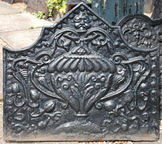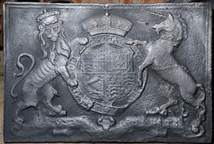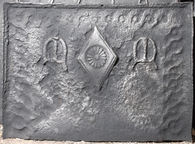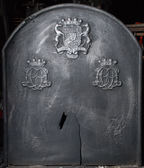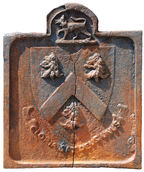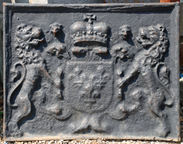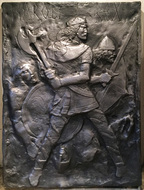-
638
Description: Rectangular with cavetto curves rising to corners and a ‘pediment’ top; fillet edging with low-relief, alternate regularly-spaced semi-circles and triangles inside; two-handled flower vase with gadrooned upper surface and symmetrical flower design in relief below; trailing vines and flowers issuing from top and descending through handles to base; human face at top; second half of date to right of vase base.
Notes: Another version, probably by a different pattern-maker, is dated 1662; a recasting; an earlier casting measures 665mm x 610mm
Copies of this fireback are known.
Inscription: [...] 52
- Decoration tags:
- rectangular with canted top corners and triangular arch (shape)
- scalloped fillet (edging)
- whole carved pattern
- pictorial
- text
- plants
- objects
Manufactured: in 1652 possibly at Brede Furnace in the Weald area of England.
Current location: Mark Ripley Forge & Fireplaces, Northbridge Street, Robertsbridge, East Sussex, England.
- Attached to series:
- Gadrooned vase firebacks
- Hooked '1' series
- Brede group
-
304
Description: Rectangular; cavetto-moulded edging; English royal Stuart shield, garter, crown, supporters and motto.
Notes: One of many designs of the Stuart royal arms on firebacks. A recasting, hence the illegible motto. Sold at Christie's Masters and Makers auction, 30 November 2010, lot 517 (£1,875).
Copies of this fireback are known.
Inscription: HONI SOIT QVI MAL Y PENSE / DIEV ET MON DROIT
Arms: English Stuart royal
- Decoration tags:
- rectangular (shape)
- cavetto (edging)
- whole carved pattern
- armorial
- royal
- text
Manufactured: in the 17th century in England.
Current location: Suffolk House Antiques, High Street, Yoxford, Suffolk, England.
- Attached to series:
- Stuart royal armorial firebacks
-
640
Description: Rectangular; ovolo-moulded edging (top and sides); repeated guilloche pattern inside top and side edges; upper centre, lozenge stamp with ovolo edges and recessed daisy flower in centre, between buckle stamps repeated twice.
Notes: The lozenge stamp is a design also seen on domestic interior panelling; the buckles suggest a Pelham family association; the buckle and lozenge are separate stamps, and in each example their relative positions differ slightly; the guilloche design appears to have been carved on the base panel; an example at The Star Inn, Alfriston, Sussex measures 665mm x 480mm.
- Decoration tags:
- rectangular (shape)
- ovolo (edging)
- carved stamps
- carved pattern panels
- heraldic
- objects
Manufactured: in the early- to mid-17th century in the Weald area of England.
Current location: Mark Ripley Forge & Fireplaces, Northbridge Street, Robertsbridge, East Sussex, England.
- Attached to series:
- Pelham family firebacks
- Pelham buckle and lozenge series
- Metalware stamp firebacks
-
641
Description: Rectangular with arched top; astragal moulded edging (top and sides); top centre, shield, supporters, coronet and motto of the 1st Baron Ashburnham: (1st & 4th) gu. a fess between six mullets ar. (Ashburnham), (2nd) az. semee of fleurs-de-lys a lion rampant guardant ar. (Holland), (3rd) erm. three crescents gu. (Kenn); on an escutcheon of pretence, sa. a chevron between three boys' heads couped at the shoulders proper each entwined around the neck with a snake vert (Vaughan). Supporters: two greyhounds sa. their faces, breasts, and feet ar. collared and lined or; below left and right, a monogram of B and J with a baron’s coronet above.
Notes: John Ashburnham, who married Bridget Vaughan in 1677, was created baron in 1689. he died in 1710. The fireback dates from between 1689 and 1710.
Inscription: LE ROY ET L’ESTAT
Arms: John, 1st Baron Ashburnham
- Decoration tags:
- rounded arched (shape)
- astragal (edging)
- carved stamps
- armorial
- text
Manufactured: in the late-17th to early-18th century probably at Ashburnham Furnace in the Weald area of England.
Current location: Mark Ripley Forge & Fireplaces, Northbridge Street, Robertsbridge, East Sussex, England.
- Attached to series:
- Ashburnham family firebacks
- Personal armorial firebacks
-
642
Description: Rectangular; twisted rope edging (top and sides); length of twisted rope parallel with, and equal to, top edge; length of rope, equal to side edge, repeated twice slanting from near top middle to bottom corners.
Notes: Very simple design using only two lengths of rope.
- Decoration tags:
- rectangular (shape)
- rope (edging)
- simple stamps
- objects
Manufactured: in the 16th century in the Weald area of England.
Current location: Mark Ripley Forge & Fireplaces, Northbridge Street, Robertsbridge, East Sussex, England.
- Attached to series:
- Rope design firebacks
-
643
Description: Rectangular, with canted top corners; twisted rope edging (top and sides only); eight shields of Ayloffe impaling Sulyard in three rows, 3-2-3; Ayloffe: sable, a lion rampant Or, collared gules, between three crosses formy of the second; Sulyard: argent, a chevron gules between three pheons inverted sable.
Notes: William Ayloffe (c1535-1584) of Bretons, Hornchurch, Essex, Justice of the Court of Queen’s Bench, married (c1560) Jane, dau. of Sir Eustace Sulyard, of Runwell, Essex. Christie's Masters and Makers Sale, South Kensington, 30 Nov 2010, lot 518 (£1,000).
Copies of this fireback are known.
Arms: Ayloffe impaling Sulyard (William Ayloffe of Bretons, Hornchurch)
- Decoration tags:
- rectangular with canted top corners (shape)
- rope (edging)
- carved stamps
- armorial
Manufactured: in the early-17th century in the Weald area of England.
Current location: not known.
- Attached to series:
- Ayloffe series
- Personal armorial firebacks
-
821
Description: Arched rectangular shape; fillet edging; shield, crest and motto in relief in a recessed arched rectangle.
Notes: The arms are of Weston, of West Horsley, Surrey: Sable, a chevron or between three leopards heads erased argent crowned or and langued gules; crest: a wolf passant ducally gorged or; motto: Gloria sat Deus unus - God alone is sufficient glory; the Westons were at West Horsley Place from the mid 18th century.
Inscription: GLORIA SAT DEUS UNUS [God alone is sufficient glory]
Arms: Weston family of West Horsley, Surrey
- Decoration tags:
- rectangular with round arch (shape)
- fillet (edging)
- whole carved pattern
- armorial
- text
Manufactured: in the mid- to late-19th century in England.
Current location: Mark Ripley Forge & Fireplaces, Northbridge Street, Robertsbridge, East Sussex, England.
- Attached to series:
- Personal armorial firebacks
-
833
Description: Rectangular; cavetto-moulded edging; armorial of France modern in front of a cartouche; above, an English royal crown between two small lion masks; two lion rampant supporters.
Notes: Believed to be associated with the marriage, in 1625, of Charles I with Princess Henrietta Maria of France, the juxtaposition of the arms of France with an English crown is seen on several firebacks, normally with a distinctive ornate edging; on this fireback is the unusual addition of two lion supporters, which are heraldically incorrect.
Arms: France modern
- Decoration tags:
- rectangular (shape)
- cavetto (edging)
- whole carved pattern
- armorial
Manufactured: in the early- to mid-17th century possibly in the Weald area of England.
Current location: Mark Ripley Forge & Fireplaces, Northbridge Street, Robertsbridge, East Sussex, England.
- Attached to series:
- Miscellaneous royal firebacks
- Anglo-French armorial firebacks
-
839
Description: Fragment (left quarter missing - symmetrical design assumed); rectangular; twisted rope edging (top and sides); top centre, crowned Tudor shield between two lions passant, the left lion guardant sinister; below each lion, two leftward heading ‘imp’ stamps, the left one of each with arms down and head facing right, the right with right arm raised; in the top corner(s), a crowned rose stamp with a ‘daisy’ stamp towards the middle.
Notes: Assuming the crowned shield is central, the fireback would have originally measured 1160mm wide; one of the ‘Royal’ series.
Arms: Tudor royal arms of England
- Decoration tags:
- rectangular (shape)
- rope (edging)
- carved stamps
- heraldic
- armorial
- animals
- plants
Manufactured: in the mid-16th century in the Weald area of England.
Current location: in private hands Battle, East Sussex, England.
- Attached to series:
- Royal series
-
1065
Description: Rectangular; no edging; rough background with 'incised' inscription across top in archaic lettering; central crowned male figure, in Saxon costume, standing astride and facing right, holding a battleaxe to his right in both hands; behind him to the right, a figure wearing a Norman-style helmet with nasal guard, advancing, with a shield, and a sword in his right hand; behind the central figure and to his right, a fallen figure with a circular shield covering him; below, the face of another fallen figure, also wearing a Norman helmet.
Notes: A dramatic pictorial fireback commemorating the Battle of Hastings. The pattern may have been made of a sculpted medium, such as clay.
Inscription: HAROLD REX
- Decoration tags:
- rectangular (shape)
- none (edging)
- whole carved pattern
- pictorial
- text
- humans
- objects
Manufactured: in the 20th century in England.
Current location: Mark Ripley Forge & Fireplaces, Northbridge Street, Robertsbridge, Salehurst, East Sussex, England.
- Attached to series:
- Commemorative firebacks
